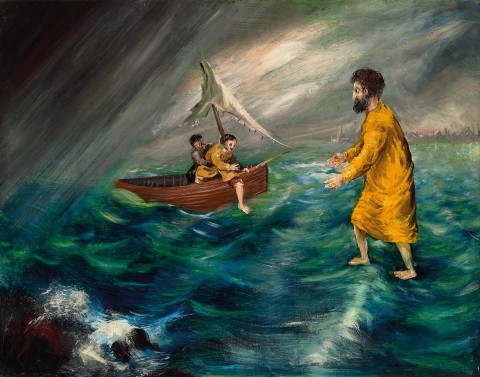CHRIST WALKING ON THE WATER, c.1947 – 48
ARTHUR BOYD
oil on composition board
67.0 x 85.5 cm
signed lower right: Arthur Boyd
Stanley Coe Gallery, Melbourne
John and Sunday Reed, Melbourne, acquired from the above in 1951
Blue Boy Gallery, Melbourne
Private collection, Adelaide, acquired from the above in the late 1970s
Deutscher and Hackett, Melbourne, 28 November 2012, lot 26
Private collection, Melbourne
Paintings by Arthur Boyd, Stanley Coe Gallery, Melbourne, 18 – 27 September 1951, cat. 9
A Melbourne Collection of Paintings and Drawings, Museum of Modern Art of Australia, (Heide) Victoria, 30 September – 10 October, 1958, cat. 25
The Bulletin, Sydney, vol. 72, no. 3737, 26 September 1951, p. 25
Reid, B. (ed.), A Melbourne Collection of Paintings and Drawings, Publication No. 1, Museum of Modern Art of Australia, Victoria, 1958, p. 68
Philipp, F., Arthur Boyd, Thames and Hudson, London, 1967, cat. 3.19, pp. 140, 142, 243 (dated 1950 – 52)
Bungey, D., Arthur Boyd: A Life, Allen and Unwin, Sydney, 2007, pp. 253, 393, 398
Christ Walking on the Water, 1950 – 52, lead glazes on ceramic, 31.5 x 41.5 cm, in the collection of the Art Gallery of New South Wales, Sydney
We are grateful to Brenda Martin Thomas, wife of the late David Thomas AM, for kindly allowing us to reproduce David’s research and writing in this catalogue entry.
Arthur Boyd’s early biblical paintings in oil and tempera found their ‘crowning and completion’ in The Grange murals of 1948 – 49.1 Biblical themes continued to appear in his ceramic paintings of 1949 – 52 and the arresting ceramic sculptures of 1952 – 53 which followed. Tragically, the mural paintings at Harkaway, with their narratives of The Prodigal Son and Susannah, are now known only through photographs and a restored fragment held by the National Gallery of Australia although, there are many treasured examples in public and private collections. Memorable among the former are The Golden Calf, 1947 in the collection of the Art Gallery of Ballarat, Victoria, and The Expulsion, 1947 – 48 in the Art Gallery of New South Wales, Sydney and The Mining Town (Casting the Money Lenders from the Temple), c.1946 – 47 (National Gallery of Australia). Of the painted ceramics, the related work, Christ Walking on the Water, 1950 – 52 is also in the Sydney collection.
For Boyd, it was a period of much experiment and stunning achievement as he combined the study of the techniques of the Old Masters with the richly creative influences of Bosch, Pieter Bruegel the Elder, Tintoretto, and Rembrandt. In The Grange murals, the influence of Rembrandt and Tintoretto come to the fore, painted with ‘a warm Venetian richness.’2 This ‘Venetian affinity’, especially that of Tintoretto, is evident in Christ Walking on the Water, c.1947 – 48 suggesting that the likely date for the oil painting is the late forties rather than early fifties, as previously given. In his scholarly 1967 catalogue of Boyd’s works, Franz Philipp gave a questioned date of 1950 – 52, adding – ‘The owner believes that the painting is from approximately the same time as the two ceramic paintings (cat. 6.17, 6.23) based on it’ – however, Philipp groups this work in the catalogue of 19 Biblical Paintings, dated 1945 – 50.3
The ‘owner’ referred to by Philipp were John and Sunday Reed, this being the first work by Arthur Boyd purchased by the couple. Darleen Bungey, in her biography of the artist, notes ‘In 1951 the Reeds… ‘plucked up the courage’ to buy ‘a small painting of Christ walking on the water because [they] like the figure of Christ a lot.’’4 Boyd’s 1951 solo exhibition at the Stanley Coe Gallery, Melbourne, in which Christ Walking on the Water was cat. 9, also included five additional major works of biblical subjects of the mid to late 1940s – namely Moses Throwing down the Tablets, 1946; Jacob’s Dream, 1947; Angel Spying on Adam and Eve, 1947 – 48; Expulsion, 1947 – 48; and Moses Leading the People. Since Philipp omits to include the 1951 Stanley Coe exhibition in his publication, he may have assumed the Reeds acquired the work from the 1953 Peter Bray exhibition. However, Christ Walking on the Water was not included in the catalogue for that exhibition.
Importantly, the style of the oil painting Christ Walking on the Water suggests a time when the Tintoretto/Venetian influence was at its height.5 This is seen in its freedom of execution, dramatic use of chiaroscuro, emotionally charged brushstrokes, Mannerist ambiguity of space, and the dialogue of hands. Significantly, the prominence of the yellow garment worn by Christ recalls that of the patriarch in the Prodigal Son and of Susannah in The Grange murals. Moreover, this single, dominant foreground figure is another innovation of 1947 – 48. Boyd’s inclusion of Melbourne on a watery skyline, gives the work that added validity of an Australian setting, while providing an ironic touch of the Venice of the south.
1. Philipp, F., Arthur Boyd, Thames and Hudson, London, 1967, p. 56
2. ibid., p. 56
3. ibid., p. 243
4. Bungey, D., Arthur Boyd: A Life, Allen & Unwin, Sydney, 2007, p. 253
5. Of Tintoretto, Franz Philipp noted ‘... whose influence on Boyd’s art had been in ascendancy
for some years; it reaches its greatest fullness in The Grange murals’: see ibid., p. 56
